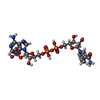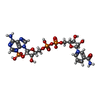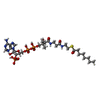+Search query
-Structure paper
| Title | Molecular basis for metabolite channeling in a ring opening enzyme of the phenylacetate degradation pathway. |
|---|---|
| Journal, issue, pages | Nat Commun, Vol. 10, Issue 1, Page 4127, Year 2019 |
| Publish date | Sep 11, 2019 |
 Authors Authors | Nitish Sathyanarayanan / Giuseppe Cannone / Lokesh Gakhar / Nainesh Katagihallimath / Ramanathan Sowdhamini / Subramanian Ramaswamy / Kutti R Vinothkumar /    |
| PubMed Abstract | Substrate channeling is a mechanism for the internal transfer of hydrophobic, unstable or toxic intermediates from the active site of one enzyme to another. Such transfer has previously been ...Substrate channeling is a mechanism for the internal transfer of hydrophobic, unstable or toxic intermediates from the active site of one enzyme to another. Such transfer has previously been described to be mediated by a hydrophobic tunnel, the use of electrostatic highways or pivoting and by conformational changes. The enzyme PaaZ is used by many bacteria to degrade environmental pollutants. PaaZ is a bifunctional enzyme that catalyzes the ring opening of oxepin-CoA and converts it to 3-oxo-5,6-dehydrosuberyl-CoA. Here we report the structures of PaaZ determined by electron cryomicroscopy with and without bound ligands. The structures reveal that three domain-swapped dimers of the enzyme form a trilobed structure. A combination of small-angle X-ray scattering (SAXS), computational studies, mutagenesis and microbial growth experiments suggests that the key intermediate is transferred from one active site to the other by a mechanism of electrostatic pivoting of the CoA moiety, mediated by a set of conserved positively charged residues. |
 External links External links |  Nat Commun / Nat Commun /  PubMed:31511507 / PubMed:31511507 /  PubMed Central PubMed Central |
| Methods | EM (single particle) |
| Resolution | 2.9 - 3.3 Å |
| Structure data | EMDB-9873, PDB-6jql: |
| Chemicals |  ChemComp-NDP:  ChemComp-NAP:  ChemComp-CO8:  ChemComp-COO: |
| Source |
|
 Keywords Keywords | HYDROLASE / substrate channeling / bi-functional enzyme / dehydrogenase |
 Movie
Movie Controller
Controller Structure viewers
Structure viewers About Yorodumi Papers
About Yorodumi Papers












